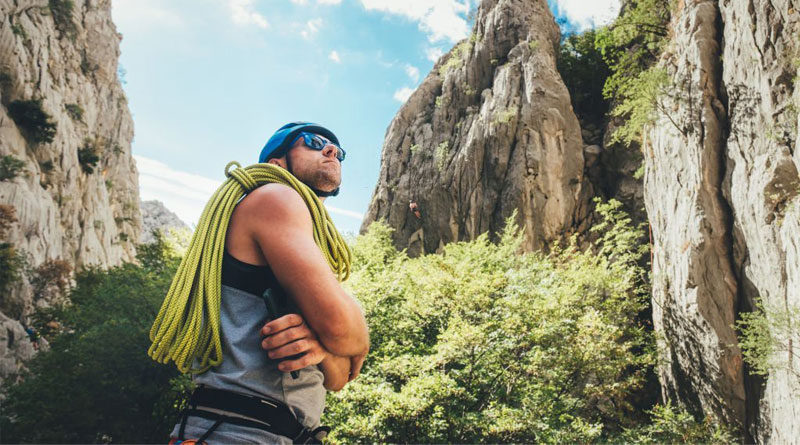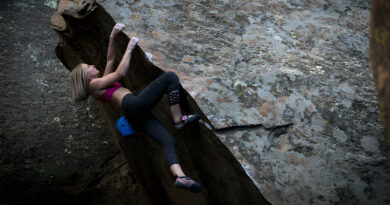Dry vs. Non-Dry Climbing Ropes: The Differences
When it comes to climbing ropes, “dry” refers to a type of rope treatment that makes the rope resistant to water absorption. This can be important for climbing in wet conditions or when climbing ice, as a wet rope can become heavier and lose its strength. A dry-treated rope is typically more expensive than a non-dry-treated rope but can be worth the investment if you frequently climb in wet conditions. A non-dry-treated rope is more affordable and may be suitable for dry environments, but should not be used in wet conditions as it can become heavier and lose its strength when wet.
What is a Dry Climbing Rope?
A dry climbing rope is one that has been treated to be resistant to water absorption. This is typically accomplished through the application of a coating or finish that repels water, preventing the rope from becoming saturated and heavy. Dry ropes are especially useful for climbers who frequently encounter wet or icy conditions because they retain their strength and performance even when wet.
Dry ropes are classified into two types: single and double. Single ropes are used for climbing routes where the climber clips the rope into protection as they ascend. Double ropes are clipped in alternately to provide redundancy and reduce rope drag on routes that require longer rappels, such as multi-pitch climbs. Dry ropes can be made from either type of rope.
In general, dry ropes are more expensive than non-dry ropes. This is due to the additional materials and time required to treat the rope to resist water absorption. However, for climbers who frequently climb in wet or icy conditions, the benefits of a dry rope may be worth the investment. The additional expense may be viewed as a necessary expense to ensure safety and optimal performance in difficult environments.
What is a Non-Dry Climbing Rope?
A non-dry climbing rope is one that has not been treated to repel water. These ropes are usually made of nylon or polyester and can be used in dry conditions. Non-dry ropes are generally less expensive than dry ropes, making them a popular choice among budget climbers or those who prefer to climb in dry environments.
Non-dry ropes, on the other hand, should not be used in wet or icy conditions because they can become heavy and lose strength when saturated with water. When a non-dry rope gets wet, it absorbs water, increasing its weight and causing it to stretch, reducing its strength and making it more difficult to manage.
Despite these limitations, non-dry ropes remain a popular choice among many climbers. They are less expensive than dry ropes and can be used in dry conditions. Non-dry ropes are also more durable than dry ropes and can last longer if properly cared for and maintained.
It is critical to note that non-dry ropes should only be used in dry conditions and never in wet or icy conditions. To ensure safety and optimal performance, climbers should always check the weather conditions before heading out and select the appropriate rope for the climb.
Which one is Right for you?
Choosing the right type of climbing rope is determined by several factors, including the environment in which you will be climbing, the type of climbing you will be doing, as well as your personal preferences and budget.
If you frequently climb in wet or icy conditions, a dry climbing rope may be the best choice for you. A dry rope is treated to resist water absorption, which aids in the preservation of strength and performance in wet conditions. However, because dry ropes are generally more expensive than non-dry ropes, a non-dry rope may be a more affordable and suitable option if you primarily climb in dry conditions.
If you’re unsure which type of rope to choose, consider the type of climbing you’ll be doing. For example, if you’re doing single-pitch climbs and won’t be rappelling frequently, a single dry or non-dry rope may be sufficient. On the other hand, if you’re doing multi-pitch climbs and will be rappelling frequently, a double dry or non-dry rope may be a better option.
Finally, the type of rope you choose will be determined by your personal needs and preferences. It’s important to do your research, consider your options, and choose a rope that is appropriate for the climb you’ll be doing and that you feel comfortable using.
Care and Maintenance of Climbing Ropes
Proper care and maintenance of climbing ropes are crucial for ensuring their safety and longevity. This is true for both dry and non-dry ropes.
Keeping your climbing rope clean is one of the most important things you can do to care for it. Dirt and debris can accumulate on the rope over time, causing it to stiffen and become less flexible. This can also cause more wear and tear on the rope, compromising its strength and safety. Simply soak your rope in warm water with a mild detergent before gently scrubbing it with a soft brush and thoroughly rinsing it.
Storing your rope properly is also important for its care and maintenance. Ropes should be stored in a cool, dry place away from direct sunlight and heat sources. When storing your rope, make sure it is coiled loosely and not tightly wound or kinked, as this can cause it to become damaged or weakened.
It’s also critical to inspect your rope on a regular basis for signs of wear and tear. Look for frayed or damaged fibers, as well as areas where the rope has been subjected to excessive heat or abrasion. If you notice any signs of damage, replace the rope right away to ensure your safety while climbing.
Finally, because different ropes require different care and maintenance, it’s critical to follow the manufacturer’s instructions for your specific rope. By properly maintaining your climbing rope, you can ensure that it remains strong and safe for future climbs.
Conclusion
In conclusion, choosing the right climbing rope is crucial for safety and optimal performance while climbing. Dry ropes are better suited to wet or icy conditions because they resist water absorption, whereas non-dry ropes are better suited to dry environments. The care and maintenance of your rope, whether dry or wet, is also essential to its longevity and safety. Cleaning and storing your rope properly, as well as inspecting it on a regular basis for signs of wear and tear, can help ensure that it remains in good condition for future climbs.
At the end of the day, the type of rope you choose will be determined by your personal needs and preferences, as well as the type of climbing you intend to do. You can choose a climbing rope that is appropriate for your needs and that you feel confident using by conducting research and considering all of your options. Your climbing rope, with proper care and maintenance, can help you achieve your climbing goals safely and successfully.




